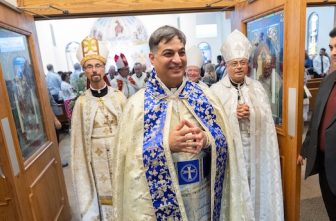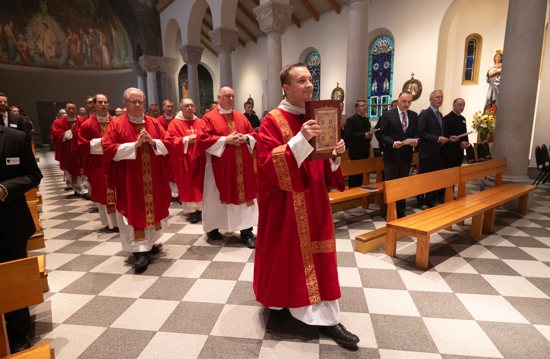
The sun shines brightly through the stained-glass windows of St. Mary’s Chapel on Summit Avenue in St. Paul as seminarians stream in for daily Mass at The St. Paul Seminary.
The pews fill up quickly; the seminary, adjacent to the University of St. Thomas campus, now has 100 seminarians in formation — the most in a decade, putting it essentially at capacity.
This year’s graduating class is a large one: 16 seminarians, including 11 from the Archdiocese of St. Paul and Minneapolis, will be ordained priests this spring and summer. Two other seminarians studying in Rome for the archdiocese will join in the ordination.
“When I came here five years ago, we knew we needed to grow from that fall’s enrollment of 70 seminarians,” said Father Joseph Taphorn, 52, rector of The St. Paul Seminary. “We set a goal for ourselves to grow to 90 within three to five years and met that goal.”
The St. Paul Seminary’s growth bucks the trend of declining seminarian enrollment in the United States. Last June, data from the Center for Applied Research in the Apostolate at Georgetown University showed a continuing decline in priestly vocations, falling from 6,400 men in 1970 to 2,759 in the most recent academic year, 2022-2023.

FUN FACTS
- Founded in 1894 by then-Archbishop John Ireland, The St. Paul Seminary was built on Summit Avenue in St. Paul due in large part to the generosity of James J. and Mary Mehegan Hill.
- The St. Paul Seminary is one of 41 major seminaries in the United States; a man is ordained a priest only after completing major seminary. Some seminarians may have attended a college seminary such as St. John Vianney College Seminary, The St. Paul Seminary’s neighbor on the campus of the University of St. Thomas. Others discern their call following their completion of an undergraduate degree.
- Seminarians at The St. Paul Seminary currently come from 16 dioceses and religious orders: St. Paul and Minneapolis; Boise, Idaho; Crookston; Des Moines, Iowa; Duluth; Fargo, North Dakota; Hartford, Connecticut; Helena, Montana; Lafayette, Indiana; New Ulm; Omaha, Nebraska; Rapid City and Sioux Falls in South Dakota; St. Cloud; Winona-Rochester and Pro Ecclesia Sancta, a religious order with missions in California, Michigan, Minnesota and South Dakota.
- In 2021, the seminary experienced its largest one-year seminarian enrollment increase since 1975, going from 70 to 90 seminarians. Median enrollment across U.S. major seminaries is 72, according to the Center for Applied Research in the Apostolate at Georgetown University.
- The St. Paul Seminary estimates that its priest alumni have celebrated the Eucharist over 24.6 million times.
- Notable alumni include a total of 37 Catholic bishops, including the Venerable Bishop Fulton Sheen, Bishop Andrew Cozzens, Bishop Joseph Williams and Bishop Michael Izen.
- The St. Paul Seminary is a hub of formation for the Archdiocese of St. Paul and Minneapolis, also offering robust programs for deacon and lay formation. There are 33 men in the Institute for Diaconate Formation, 18 of whom were ordained in December — tying the record for the largest archdiocesan deacon class. Nearly 100 men and women are enrolled in lay graduate programs, and 800 people participate in leadership institutes: the Catechetical Institute, the Institute for Catholic School Leadership and the Institute for Ongoing Clergy Formation.
- To learn more about the seminary, visit SaintPaulSeminary.org.
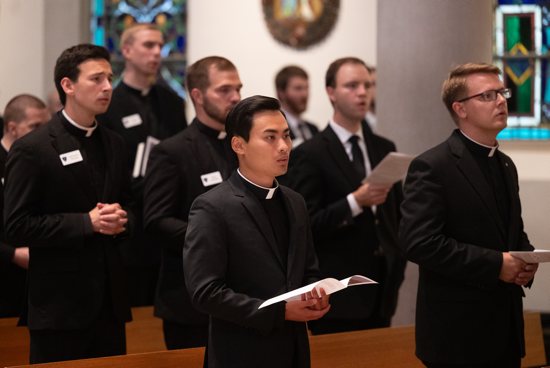
“Maybe our numbers will go down as we’re graduating a large class, and there are always some men who will discern out — that’s normal and part of the process,” Father Taphorn said. “But we see growth continuing as we continue to have a quality program. Ultimately, it’s God, it’s grace, that grows our seminary.”
The journey through major seminary, as outlined by the Church, includes four dimensions of priestly formation: human, academic, pastoral and spiritual. The U.S. Conference of Catholic Bishops (USCCB) Program for Priestly Formation, Sixth Edition, consists of three stages: propaedeutic, discipleship and configuration.
“All seminaries have these stages; we’re all held to the same menu in a certain sense,” Father Taphorn said.
“But notably in 2021, The St. Paul Seminary was one of the first in North America to institute the new propaedeutic stage, a year set apart for seminarians to focus on human and spiritual formation,” he said. “That has served us well and is something I’m very proud of.”

The core of the propaedeutic stage is growth in prayer, trust and fraternity. At The St. Paul Seminary, a key component is individual and group counseling for seminarians, led by Paul Ruff, 67, assistant director of human formation and director of counseling services, and a licensed psychologist.
“A seminarian’s process group meeting — I like to call it a growth group — attends to what’s going on within the person in the group and between members of the group,” Ruff said.
“We start with prayer and then a check-in — the seminarians can share how they’re doing and what’s on their mind, i.e. managing anxiety, past trauma, family of origin, how to live a chaste life; this reflective awareness is a way for men to be deeply known in a vulnerable way, and really lends itself to human growth and integration,” he said.
Ruff noted that during the propaedeutic stage, seminarians don’t use their phones or other devices except for about an hour each Saturday to check email. They fast from social media.
“With the oversaturation of technology and media, there are such ready escapes, like ‘I’ll just turn on a YouTube video’ versus learning to understand what I am feeling, dealing with those feelings, and becoming more resilient in my life,” Ruff said.
Ruff said the seminarians appreciate the fast; “they usually find they’re happier.”
“I find our seminarians are very dedicated to the spiritual and prayer life and also willing to be challenged to grow humanly,” said Ruff. “That’s a testament to our sense of vision and the programming we’re doing here at the seminary — we’re all rowing in the same direction.”
Bishop Andrew Cozzens of the Diocese of Crookston, 55, former auxiliary bishop of the Archdiocese of St. Paul and Minneapolis who served as interim rector of The St. Paul Seminary from June 2018 to January 2019, believes that the seminary is ahead of the curve in terms of the propaedeutic stage and integrating deep human and spiritual formation with the rest of the program’s formation.
“That vision has permeated the whole seminary life; every seminarian has a human formator and a spiritual formator who meets with him every two weeks — consistent formation,” Bishop Cozzens said.
“I’ve often argued that you will not find in any other profession — no medical school, no law school — a more integrated formation than that in the current seminary experience, and The St. Paul Seminary is a leader in that formation,” he said.
Bishop Cozzens noted another strength of the seminary: its spiritual formation, specifically an openness to the Holy Spirit for the seminarians to be the new evangelists of today’s world.
“It’s the bishops who choose the seminary for their diocese; thus, the story of success is when bishops begin to see that the men coming out of The St. Paul Seminary are able to give themselves freely, because they are formed well,” Bishop Cozzens said.
Another component of a seminarian’s journey is academic formation — studies that the Vatican and the USCCB deem necessary for the education of a diocesan priest.

“Seminarians prepare for priestly life and ministry through a rigorous Master of Divinity degree that requires a great variety of coursework including classes in philosophy, theology and Latin as well as pastoral formation courses and ministry training,” said Brandon Wanless, 38, assistant professor of dogmatic theology.
“Regarding theological formation, seminarians take several courses each in dogmatic theology, moral theology, sacred Scripture, Church history and sacramental theology,” Wanless said.
“The men I teach here in seminary formation are eager, friendly, bright and engaging — they are serious about serving God’s people and have clear aptitude for that work,” he said.
The seminarians complete the Master of Divinity degree program over a four-year cycle, including summers and January terms, in a fully immersive residential experience. The daily schedule includes morning and evening prayer and Mass at 11:45 a.m., classes, meetings, recreation and study.
“We’re blessed here with the January term model; we’ve used that month to develop a core of international excursions, giving seminarians some space to be formed in very powerful experiences you can’t do in a classroom setting,” Father Taphorn said.
The St. Paul Seminary also offers a nationally-renowned teaching parish program, where seminarians receive hands-on experience in a parish setting, as well as hospital ministry to the sick and suffering.
“And we’re proud of our rural ministry,” Father Taphorn said. “Seminarians spend a week in the summer visiting farms, learning about ecology and understanding the differences between ministry in rural and urban settings.”
Father Taphorn said that about 80 percent of men who come to The St. Paul Seminary become priests.
“It’s a high percentage,” he said. “Our outstanding faculty, dedicated staff and robust counseling teams are probably what sets the seminary apart the most. And we try to set a vision to make this place a home, creating openness, honesty, transparency and, notably, a culture of growth, not a culture of conformity.”
“This is a place where seminarians want to be, and that attracts other men discerning their call, plus their vocation directors and bishops,” said Father Taphorn.
“It’s a privilege being a spiritual father to future priests and seeing them come alive,” Father Taphorn said. “They are making a commitment to something very big and bigger than themselves; they know that and are ready to engage.”
JOURNEYS TO PRIESTHOOD

“I first encountered the love of God in ninth grade at Extreme Faith Camp, and it was there that I sensed a call to the priesthood. After high school, I served a year with NET Ministries and discovered a deep love for serving people spiritually. I then entered St. John Vianney College Seminary in 2015 and began my studies at The St. Paul Seminary in 2019.”
Seminary Experience
“In some ways, the brothers walking with me are one of the biggest sources of formation here at the seminary. When you are surrounded by 100 good-hearted men who want to lay their lives down out of love of God and his people, it naturally rubs off on you and inspires you to keep seeking higher things and move in the right direction.
“There’s a wonderful sense of fraternity here, and the halls are often filled with life and laughter … I think one of the biggest reasons for The St. Paul Seminary’s success is the culture of the house. There is a genuine joy, and guys are free to be themselves, and this creates a very healthy atmosphere where guys are open to formation and growth.”
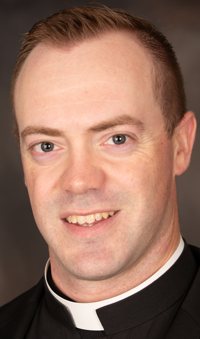
“After graduating from the U.S. Military Academy at West Point in 2012, I served as a field artillery officer in the U.S. Army in Fairbanks, Alaska. I found myself in a lot of conversations with my soldiers and recognized in myself a desire to be more of a spiritual father, which led me to start asking, ‘What is the Lord actually calling me to do?’ I entered Mundelein Seminary in Illinois from the Diocese of Fairbanks and transferred to The St. Paul Seminary after being accepted by the Diocese of Winona-Rochester.”
Seminary Experience
“Studying rich, deep theology with access to outstanding resources like the seminary’s library has been phenomenal — dare I say I almost miss it already as I move on. And being in a community ordered toward fatherhood has been a highlight. A lot of that comes from Archbishop (Bernard) Hebda and Father (Joseph) Taphorn, both excellent father figures who live from a sense of joy and peace.
“There’s not a lot of encouragement in the secular world these days for men to be holy fathers, so for seminarians to come here and be encouraged is indescribable. I see guys coming into the chapel in the evenings for prayer. They don’t have to be there, but something draws them. They want to be there. It’s The St. Paul Seminary.”
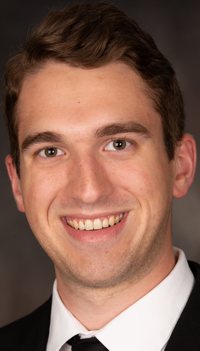
“As a student at the University of Minnesota, I went to (the) St. Lawrence Newman Center in Minneapolis. I found myself thinking about Mass when I wasn’t in church. I got involved in campus ministry, and it was in adoration that I started to grow in my belief and respond. Some have a lightning bolt moment; for me, it was the lights coming on. Right after graduating with a degree in economics, I turned down a job offer and entered the seminary.”
Seminary Experience
“I began the propaedeutic stage in August 2021. Having that chance to set aside everything and be steeped in the life of Christ and the relationship with God the Father has been a tremendous blessing. I now know that the most important thing a priest can do every day is to pray. Next year we do apostolic outreach — volunteering at places like Catholic schools and nursing homes. I’m looking forward to that pastoral formation as we recognize the role of charity in the life of Christians.
“It may sound hokey, but the seminary’s vision is the Church on fire with the Holy Spirit. It’s such a beautiful image, and you see it in the instructors, in the seminarians — the wind is blowing on those embers, and the men are so excited to ignite a flame and share that spark with others.”
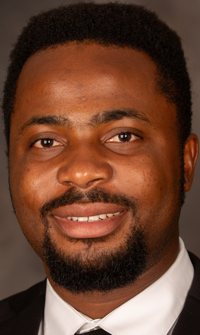
“My decision to discern the priesthood started at about age 12 when I entered minor seminary for my high school studies. Raised in a lovely Catholic home and fully involved in my local parish activities, I was influenced by my encounters with priests while serving as an altar server and by the religious sisters who taught me in elementary school.”
Seminary Experience
“After college studies at a seminary in Nigeria, I became familiar with the Diocese of Boise due to the good, humble and spirit-filled advice I received from my mentor during my pastoral year assignment in Rupert, Idaho. I started my studies at The St. Paul Seminary in the fall of 2023 and can honestly say, after so many years in the seminary, that my propaedeutic year of formation here is the best formation I have ever received.
“The seminary’s daily liturgical practices including Mass, Holy Hour silent adoration, and praying… the Divine Office have been so helpful in our spiritual formation and growth, as well as weekly prayer team training with praise and worship songs and praying for the charismatic gifts of the Holy Spirit. We have time for private spiritual devotions, deep study of the Scripture and silent retreats — all of which help us cultivate a life of prayer and a deeper relationship with our Lord.”




